Lor Hon Jai – A CNY Special
Chinese New Year is around the corner and the one dish that signifies the “crossing” into the new year for the Cantonese is the “Lor Hon Jai.” It seems like a tauntingly complicated dish with 15+ ingredients, but if you systematically space out the preparation of each ingredient over several days, it does not seem so difficult, it is almost a yearly ritual getting ready for the New Year! The trouble is, I never bothered to write it all down and every year I have to painstakingly recall what goes into the dish. No more of that, this year it is going to be written down before my memory fails me!
“Chai” suggests vegetarian but according to hard-core Asian vegetarians, my recipe far from qualifies – to start, dried oysters is one, and the use of garlic is the other. The oysters definitely add that umami taste to the dish which complements and rounds out the overall flavor of the dish.
I grew up with eating this concoction of flavors and textures every Chinese New Year (CNY), salivating in anticipation of the reunion dinner which started late on the evening of CNY eve. Late because it was intended that the dinner will last past midnight into the CNY and there would be “plenty” left in the rice pot and on the table! There were other dishes on the table too, notably “larp mhey” (preserved meats which I will write more on later) which goes very well with the “lor hon chai.” These 2 flavors in combination brings back nostalgic memories of CNY growing up!
On this auspicious occasion, mom would make it a point to cook more rice lest dad hears the bottom of the pot being scraped. All hell would break loose! Not having enough rice in the rice pot would signify a less than prosperous new year! We would have enough “chai” to last a few more days and whenever friends and family show up to pay their respects, other than the candy and cakes offered to sweeten their new year, we would offer them a small bowl of “chai” and some rice, which is an unusual treat to many who looked forward to this once a year at our house.
“Lor hon chai” is dish with an acquired taste – one may not appreciate the subtleties and combination of flavors tasting it for the first time. So, don’t serve too much to someone who is tasting it for the first time, because it is not an inexpensive dish to make! Let them ask for more of they like it.
Ingredients:
1/2 a packet of 1.5 oz dried cloud ears (wan yee)
8-10 whole hoe see (dried oysters) – optional and if available
18 Chinese dried shitaki mushrooms
1/2 of 4-oz packet dried lily flower (kam chum)
1/2 of 1-oz packet fatt choy (black moss)
1/2 of 8-oz packet of theem chook (sweetened bean curd sheets)
1 large Napa cabbage (about 3 lbs)
1 15-oz canned button mushrooms
1 15-oz canned straw mushrooms
1 15-oz canned pak kor or 9-oz fresh vacuum-packed (gingko nuts)
1 10-0z canned cha’i-pow-yu (mock abalone)
1 packet fried meen kan balls
1 meen kan (fresh gluten) – if available
18 tow fu pok (fried tofu)
1 bottle lharm yue (red fermented bean curd)
1-inch fresh ginger, microplaned
8 pips garlic, microplaned
1/4 cup canola oil
1 bundle fun see (mung bean vermicelli)
Preparation of Ingredients:
dried cloud ears (wan yee):
Place the dried cloud ears in a medium size container and pour hot water over them to cover. Let sit for 30 minutes and wood ears will triple in size once re-hydrated. Pick up each clump of wood ears and check for woodsy remnants still attached to it. This is the base of the clump where the wood ears used to be attached to the growing medium, usually you can tell from the white spot. Snip it off with a pari of kitchen shears or just pinch it off with your fingers. Separate the clumps into even large pieces, and rinse it to remove any grit or sand. Place them in a plastic bag and refrigerate for later use.
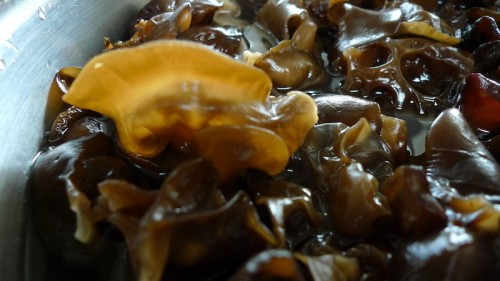
Rehydrated Cloud Ears
hoe see (dried oysters):
The hoe see is not really completely dehydrated when bought at the Asian market. Soak them in cold water for about 30 mins and rinse it to make sure there is no grit or sand. Heat a couple of tablespoons of oil in a wok, saute the hoe see with 3 minced garlic and a 1/2 inch piece of minced ginger until the hoe see are fragrant. (This should take away the fishy taste which permeates the jai after it is cooked). Place in sealed container and refrigerate for later use. It is not easy to find hoe see anymore at the Asian markets because they are expensive and an acquired taste but a necessary flavor in the melded taste of the dish.
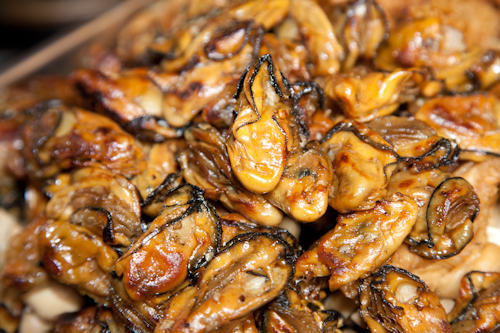
Re-hydrated (dried oysters) Hoe See
18 Chinese dried shitaki mushrooms:
Cover the mushrooms with cold water and allow to soak until you can easily cut off the stem where it attaches to the bottom of the cap. Rinse and place mushroom in a medium pot and bring to a boil, lower the heat and simmer, covered, until mushroom is tender. This could take between 45mins to an hour depending on the type of shitake mushrooms. Check for doneness by poking it with a toothpick. Halfway through simmering the mushrooms, add the hoe see to the mushroom and let simmer together until mushrooms are done. Assuming, you don’t have a lot of liquid left from the simmering, save the liquid for cooking the lor hon jai because all the flavor from the mushrooms and hoe see is in it. Set aside or refrigerate for later use.

Re-hydrated Shitaki Mushrooms
1/2 packet of dried lily buds (kam chum):
When buying dried lily buds, look for those which are lighter in color. There are 2 ends to a dried lily bud. One end is usually hard. Pinch off the hard end and if the other end is equally hard, pinch it off too. Rehydrate them in cold water for an hour or so, rinse, and set aise for later use.
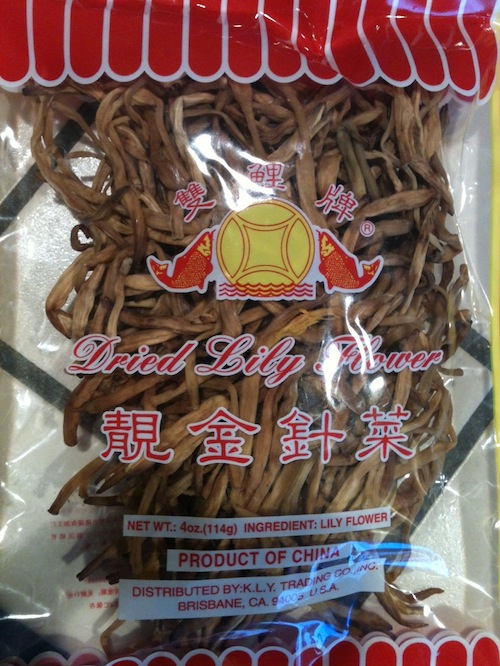
Dried Lily Flower

Re-hydrated Lily Buds
1/2 packet fatt choy (black moss):
Cut off half the dried fatt choy and save the other half for next year, but if you like more of it, use the whole packet! More fatt choy could suggest added prosperity! Soak them in cold water for a half hour on the day when you are assembling the lor hon jai. When adding it to the lor hon jai, do not just throw in the entire clump. Using your fingers, pull off small clumps and place them in the pot with the other ingredients, the smaller the clumps the better so that they can be missed in evenly.

Dried Black Moss
1/2 8-oz packet theem chook (sweetened bean curd sheets):
From the long end, cut them into 1/2″ strips and deep-fry them in batches on medium heat. They brown very quickly because they are sweetened. Do not burn them as they will give your lor hon jai a burnt taste. Set them aside. Do this on the day of your cooking the lor hon jai. The oil you used and the wok you deep-fried them in will be used for cooking the lor hon jai.
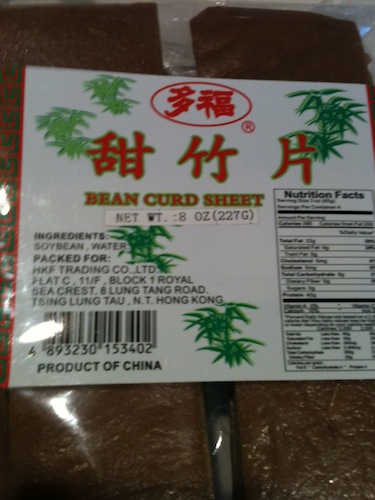
DriedBean Curd Sheets

Fried Theem Chook
1 packet fried meen kan balls
Bring to a boil 2 cups of water in a wok and place the fried meen kan balls in and cover. This is done to deflate the balls and re-hydrate them. About 5-10 mins. Set aside and discard the liquid.
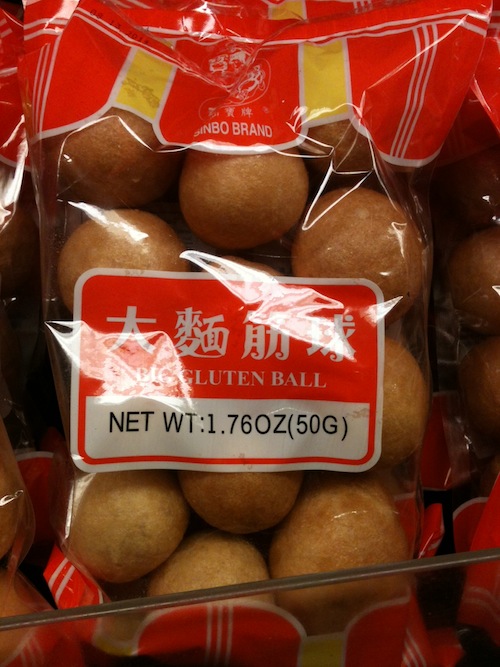
Fried Gluten Balls
1 meen kan (fresh gluten) – if available
This ingredient is getting to be a rare commodity at the Asian markets. They are usually seen at the vegetarian section together with the tofus and soaking in liquid and sold by the piece. Slice them cross-wise into 1/4-inch coins and set aside.
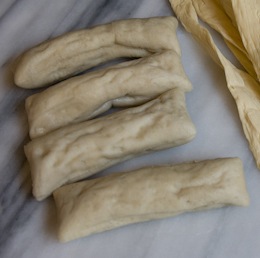
Fresh Meen Kan
18 tow fu pok (fried tofu or soya bean cake)
These are fried pieces of tofu, some can be as large as 1″ cube. If they are big, cut them in half, but if they are bite-size, leave them as is. No prep required.

Tofu Pok
1 bottle lharm yue (fermented red bean curd)
There are several brands of fermented red bean curd, mostly from China, but there is one that is of a higher quality labeled “Shanghai Style”. I have used these for years and it smells of cooking wine. It has gotten expensive compared to the other brands. I feel you can use the less expensive ones and not be able to tell the difference. Empty the entirely container into a mixing bowl and together with the liquid, mash the cakes of curd down to a thick homogenous sauce. Set aside.

Fermented Red Bean Curd – “Shanghai Style”

Red Bean Curd
1 15-oz canned button mushrooms
Discard the liquid that comes with the canned mushrooms. If the mushrooms are too big, cut them into halves and set aside. For the rest of the canned vegetables below, again, discard all the liquids that come with the vegetables and set aside.

Canned Mushrooms
1 15-oz canned pak kor or 9-oz fresh vacuum-packed (gingko nuts)
If fresh vacuumed-pack gingko nuts are not available and canned ones are, drain and discard the liquid and set aside.
1 bundle fun see (mung bean vermicelli)
Do not add the fun see to the pot of lor hon jai because when you reheat them again the fun see turns to a starchy mess. I always add fun see whenever I reheat a portion of the lor hon jai for dinner. Soak 1/2 a packet or a packet in hot water from the tap and let sit for 15 mins. When the lor hon jai comes to a simmer, add the rehydrated fun see and simmer until the lor hon jai is re-heated. Fun see cooks fast and should not be al dente.


